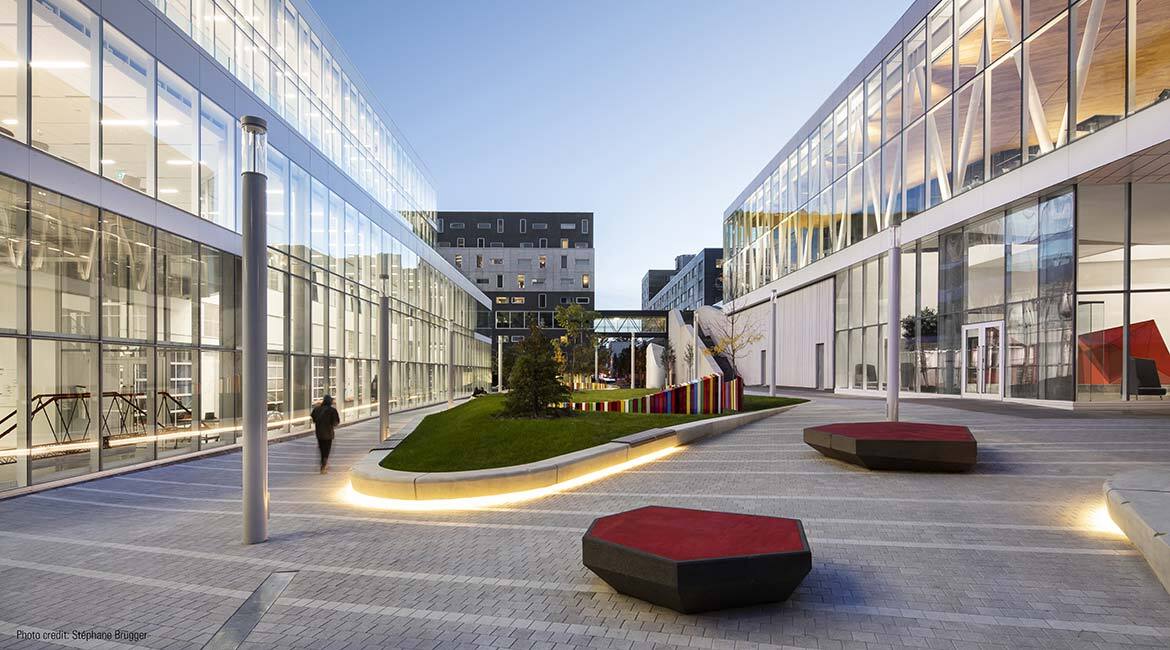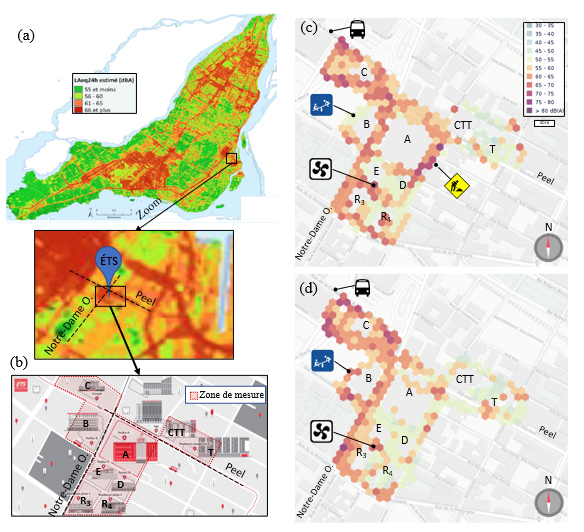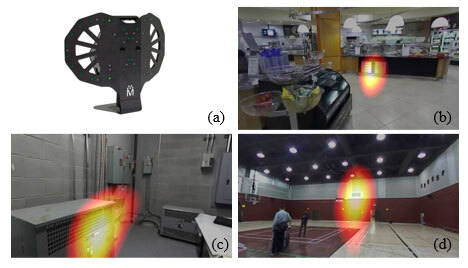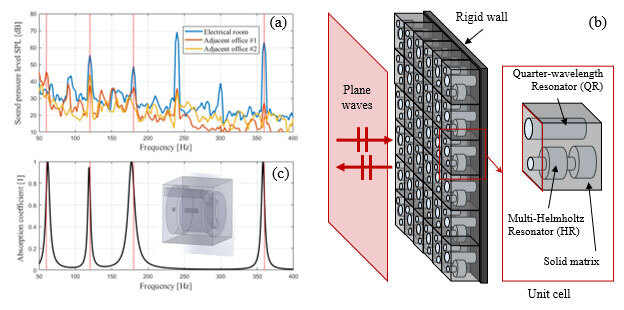Mapping Noise at ÉTS: a MEC636 Student Project

@École de technologie supérieure. Copyright.
Noise: A Major Issue in Learning Spaces
Noise can have harmful effects on people’s health:[1] hearing loss, sleep disturbance, difficulty in communicating, cardiovascular and mental effects, reduced performance, annoyance, and effects on social behaviour. In an academic environment, noise can also affect learning, especially reading comprehension, memory and speech intelligibility [2]. A number of studies on the subject have been conducted on university campuses [3][4][5] and generally concluded that noise levels are too high for this type of learning environment.
The École de technologie supérieure (ÉTS) campus is located in the heart of the city of Montréal (Canada) and is, unsurprisingly, exposed to a fairly high level of noise, as shown by the noise level mapping conducted in 2014 by Ragettli et al. [6][7] and presented in Figure 1(a). According to this map, noise levels in this neighbourhood are well above the maximum level of 55 dB(A) recommended by the World Health Organization (WHO) [1] (recommendation for outdoor school spaces).

Figure 1: (a) Noise level map of the island of Montreal (from [6][7]); (b) ÉTS campus and outdoor noise measurement zone; Mapping of outdoor noise at the ÉTS campus conducted by MEC636 students during (c) off-peak hour (2:30 to 3:30 p.m.), and (d) peak hour (4:00 to 5:00 p.m.).
Equally important are the acoustic environments inside the various university halls. They must be adapted to the learning context and conducive to office work for all campus staff. To achieve this,(i) background noise from outside sources (e.g., road traffic, air traffic, factories, schoolyards) and inside sources (e.g., ventilation, neighbouring premises) and (ii) reverberation times—a measure of the extent of reverberation in a room—must be low. Excessive reverberation and/or background noise in these spaces interfere with oral communication and are an “acoustic” obstacle to learning.
As part of their term project, a class from the ÉTS “Industrial Acoustics” course [9] (MEC636) was tasked with conducting a noise study on the ÉTS campus in order to quantify campus noise more accurately and contribute to improving acoustic environments and the quality of life of the community.
Mapping Noise on the ÉTS Campus
The first stage of the project involved a study of outdoor noise on the ÉTS campus. Detailed noise mapping identified the quietest and the noisiest areas. Unsurprisingly, this downtown campus is quite noisy, with levels exceeding WHO recommendations (above 55 dB(A)) over most of its surface area (see Figures 1(c) and 1(d)). Noise levels are highest during the day (before 4 p.m.), due to the many construction projects in the area. However, some quieter areas have been identified in the outside pedestrian courtyards between the halls and student residences.
Noise Analysis in the ÉTS Halls
The second stage consisted in characterizing sound environments of several rooms in the various ÉTS halls (auditorium, classrooms, cafeteria, offices, library) and assessing their acoustic quality. Generally speaking, the classrooms measured were quite suitable for learning—background noise below 40 dB(A) and reverberation time below 0.7 s. On the other hand, 50% of auxiliary learning spaces exceeded 45 dB(A) (gymnasium, cafeteria, atrium, collaborative space) and would benefit from corrective acoustic measures to improve the acoustic comfort of the student community. Students in the course then located the main sources of noise inside the halls using an acoustic camera (see Figure 2).

Figure 2: (a) LF-ANT acoustic camera (Mecanum, Sherbrooke QC, Canada) for acoustic imaging; Acoustic images of three premises: (b) Hall A cafeteria, (c) electrical room and (d) Hall B gymnasium. The centre of the coloured spot indicates the position of the dominant acoustic source in the room.
Proposal for an Acoustic Metamaterial to Reduce Electrical Transformer Noise
The third and final stage of the project focused on electrical and mechanical room noise in the campus halls. These rooms emit noise with a characteristic tonal signature that can be perceived in nearby rooms and disturb staff while they are working (see Figure 3(a)). The students were asked to come up with a concept for an acoustic metamaterial to enclose electrical transformers—identified as significant noise sources in the previous step—in order to reduce their potential nuisance to nearby premises (see Figure 3(b)). An acoustic behaviour simulation of the proposed metamaterial showed that the material could absorb acoustic energy at four frequencies identified as problematic in the noise spectra measured in these nearby rooms and offices (see Figure 3(c)).

Figure 3: (a) Sound pressure-level spectrum in dB in an electrical room and two neighbouring offices; (b) three-dimensional diagram of the acoustic metamaterial; (c) absorption coefficient of the metamaterial excited under normal incidence plane wave. Vertical dashed red lines are set at 60, 120, 180 and 360 Hz frequencies.
Project Continuation
This project has demonstrated the relevance of extending noise measurements to more premises and over different periods of the year. Subjective noise measurements, obtained through questionnaires, could also add to the microphone measurements and better lead the search for solutions in providing more comfortable acoustic environments.



